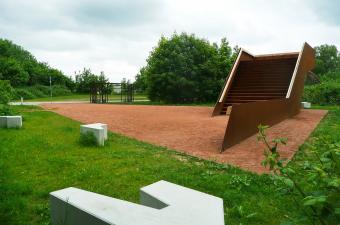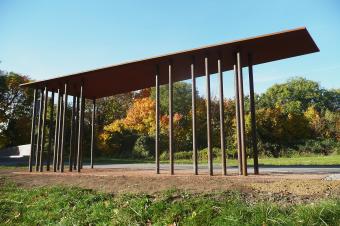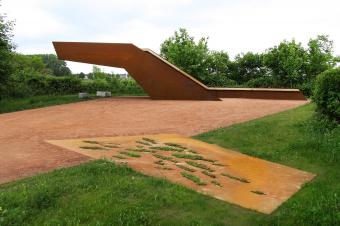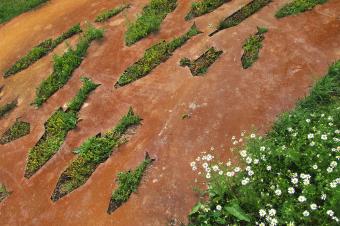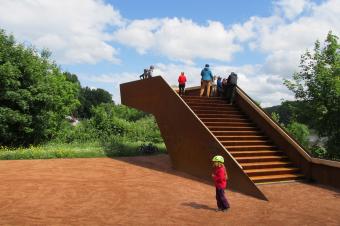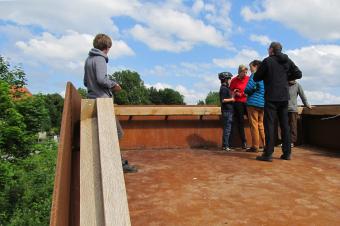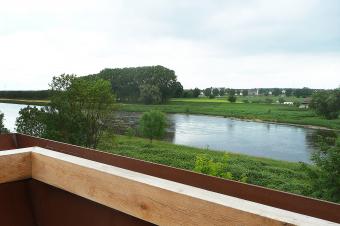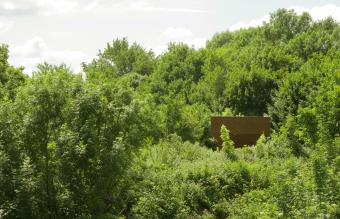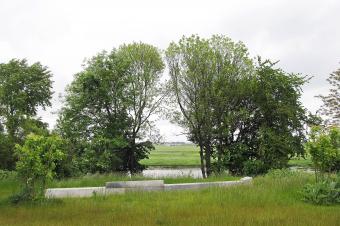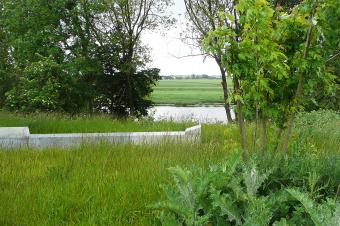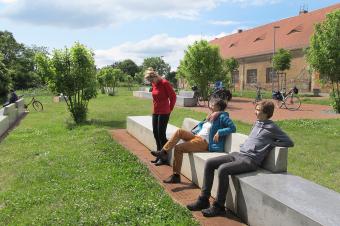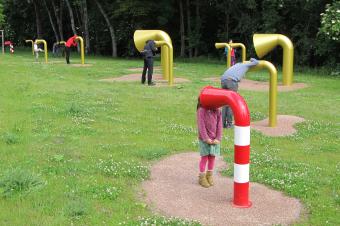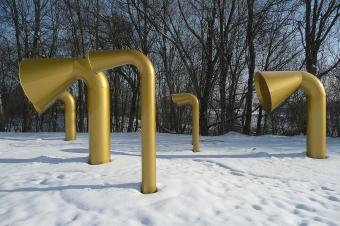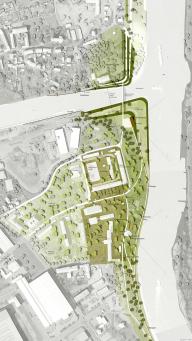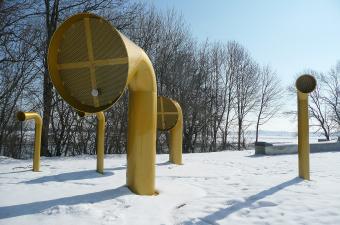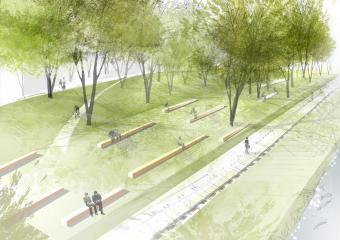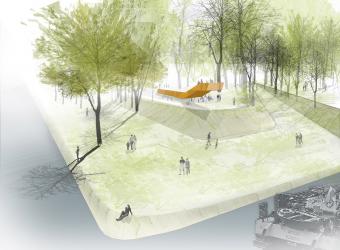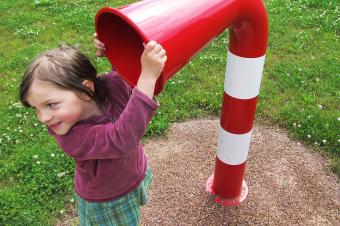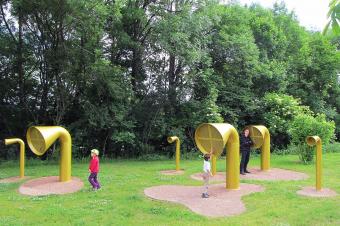項(xiàng)目背景
Project Background
里薩是易北河上的第二大內(nèi)陸港口���,鋼鐵制造業(yè)發(fā)達(dá)����,被稱為 “鋼鐵之城”。工業(yè)鐵路系統(tǒng)搬遷后�����,市政府希望修復(fù)受損的自然環(huán)境,同時(shí)將綠帶“易北線”發(fā)展成面向大眾的文旅項(xiàng)目����。新的橋梁連接城市南北,易北河畔的開放空間得到了合理的再利用�,實(shí)現(xiàn)可持續(xù)發(fā)展。為了突顯城市文化氣質(zhì)�����,該項(xiàng)目使用了各種鋼材作為節(jié)點(diǎn)的主要材料�,延續(xù)了“鋼鐵之城”的歷史。
Riesa is the second largest inland port on the Elbe, with a well-developed steel manufacturing industry and is known as the “Steel City”. After the relocation of the industrial railway system, the city government hopes to repair the damaged natural environment and at the same time develop the green belt “Elbe Line” into a cultural tourism project for the general public. The new bridge connects the north and the south of the city, and the open space on the Elbe River has been rationally reused to achieve sustainable development. In order to highlight the urban cultural temperament, the project uses various steels as the main materials for the nodes, continuing the history of the “Steel City”.
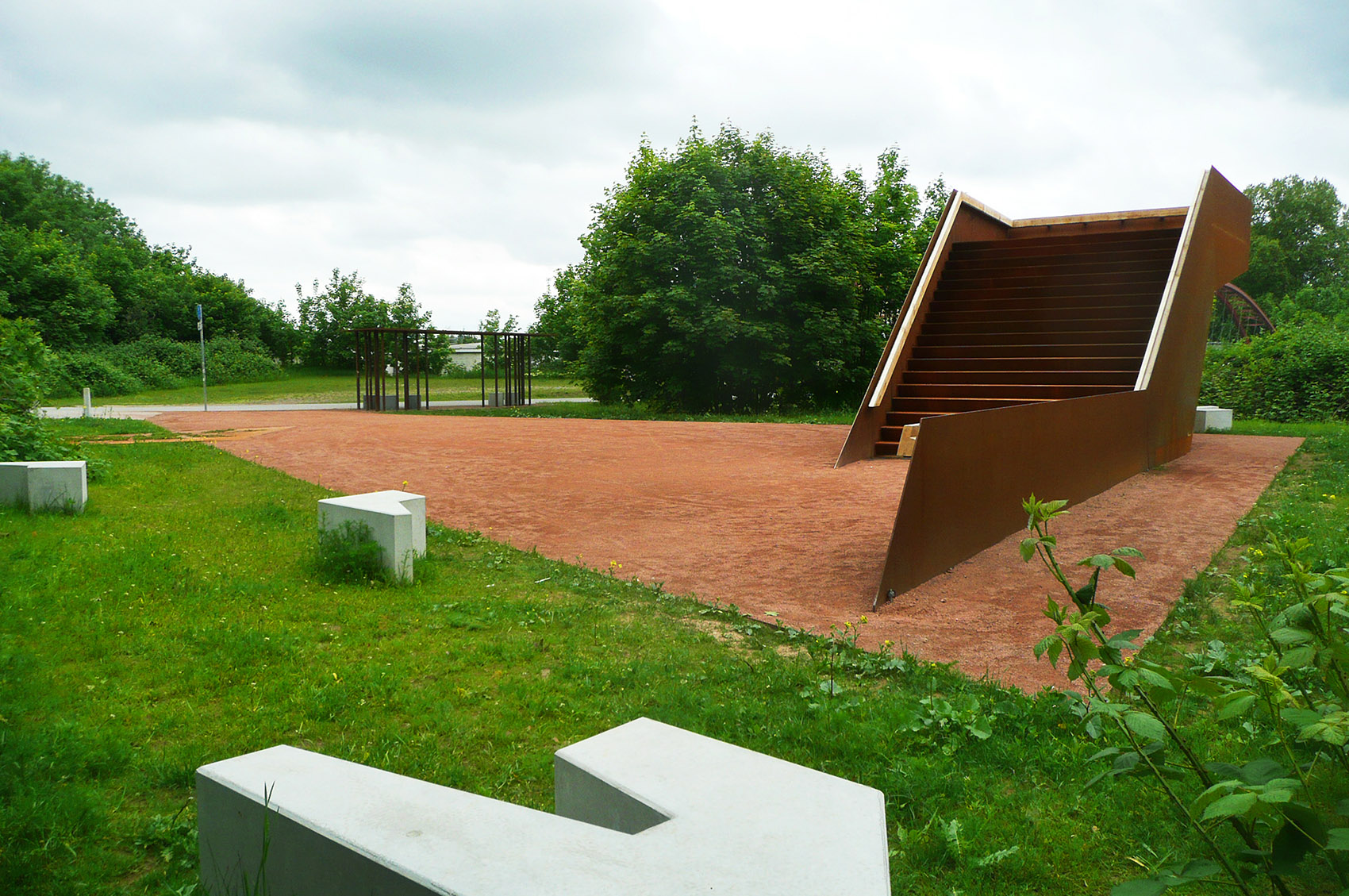
▲項(xiàng)目概覽�����,Overview ? REHWALDT LANDSCAPE ARCHITECTS
景觀廊架
Pergola
場(chǎng)地毗鄰區(qū)域自行車道網(wǎng)����。首先映入眼簾的是入口處的耐候鋼廊架。作為車道的起始點(diǎn)��,它為騎行者及其他游客提供了集合調(diào)整和休憩的空間�����。這個(gè)區(qū)域的設(shè)置銜接了河濱公園與城市自行車網(wǎng)絡(luò),使城市開放空間得到更有效的利用�。場(chǎng)地毗鄰新建的管道研究中心,因此廊架“就地取材”使用管道作為支柱�����。
The site is adjacent to the regional bicycle lane network. The first thing that catches the eye is the weather-resistant steel gallery at the entrance. As the starting point of the lane, it provides a space for cyclists and other tourists to gather, adjust and rest. The setting of this area connects the riverside park with the urban bicycle network, making the urban open space more effective. The site is adjacent to the newly built pipeline research center, so we use weather-resistant steel pipelines as pillars for the corridor frame.
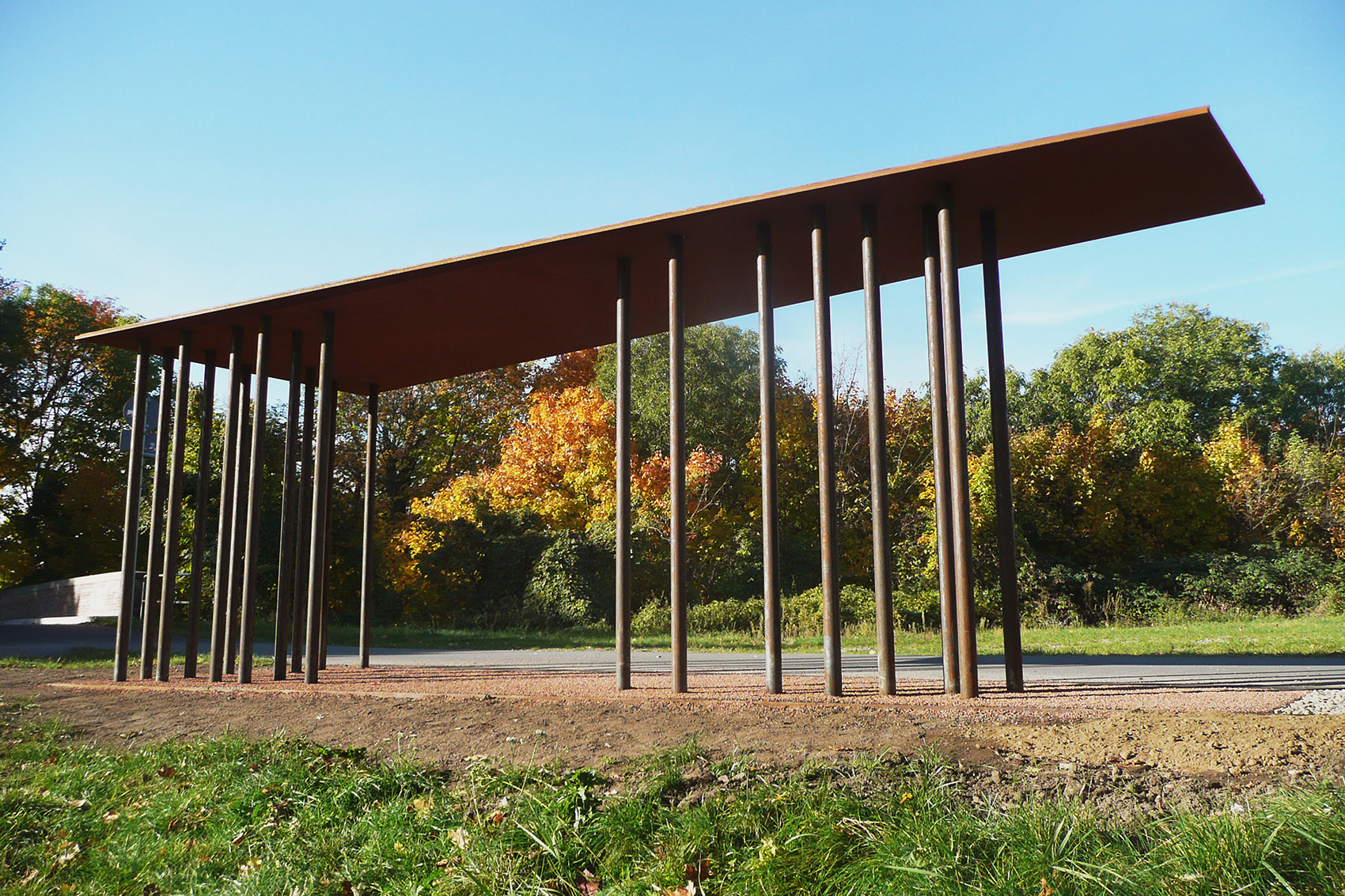
▲廊架作為自行車道節(jié)點(diǎn)地標(biāo)�����,銜接公園與自行車道網(wǎng)����,The corridor serves as a landmark of the bicycle path node, connecting the park and the bicycle path network ? REHWALDT LANDSCAPE ARCHITECTS
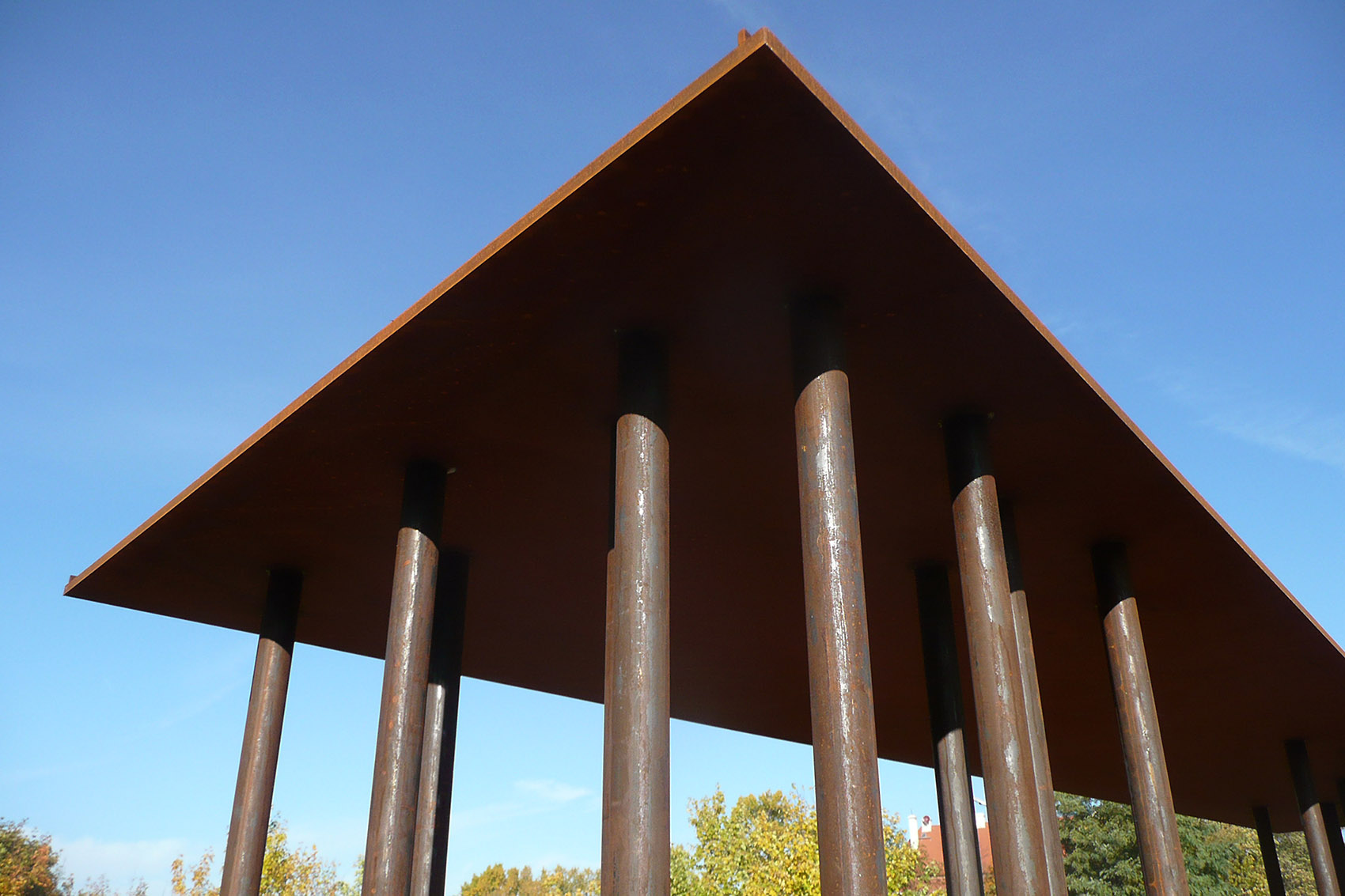
▲管道作為廊架支柱��,The pipe is used as a pergola support ? REHWALDT LANDSCAPE ARCHITECTS
瞭望臺(tái)
Observation Platform
地面上鑲嵌的鏤空鋼板���,以其特殊質(zhì)感���,引導(dǎo)游客前往易北河畔和港口。鏤空板上的游魚圖案���,契合航運(yùn)和河流主題��。
The hollow weather-resistant steel plate, with its special texture, guides tourists to the river Elbe and the port. The fish pattern on the openwork fits the theme of shipping and rivers.
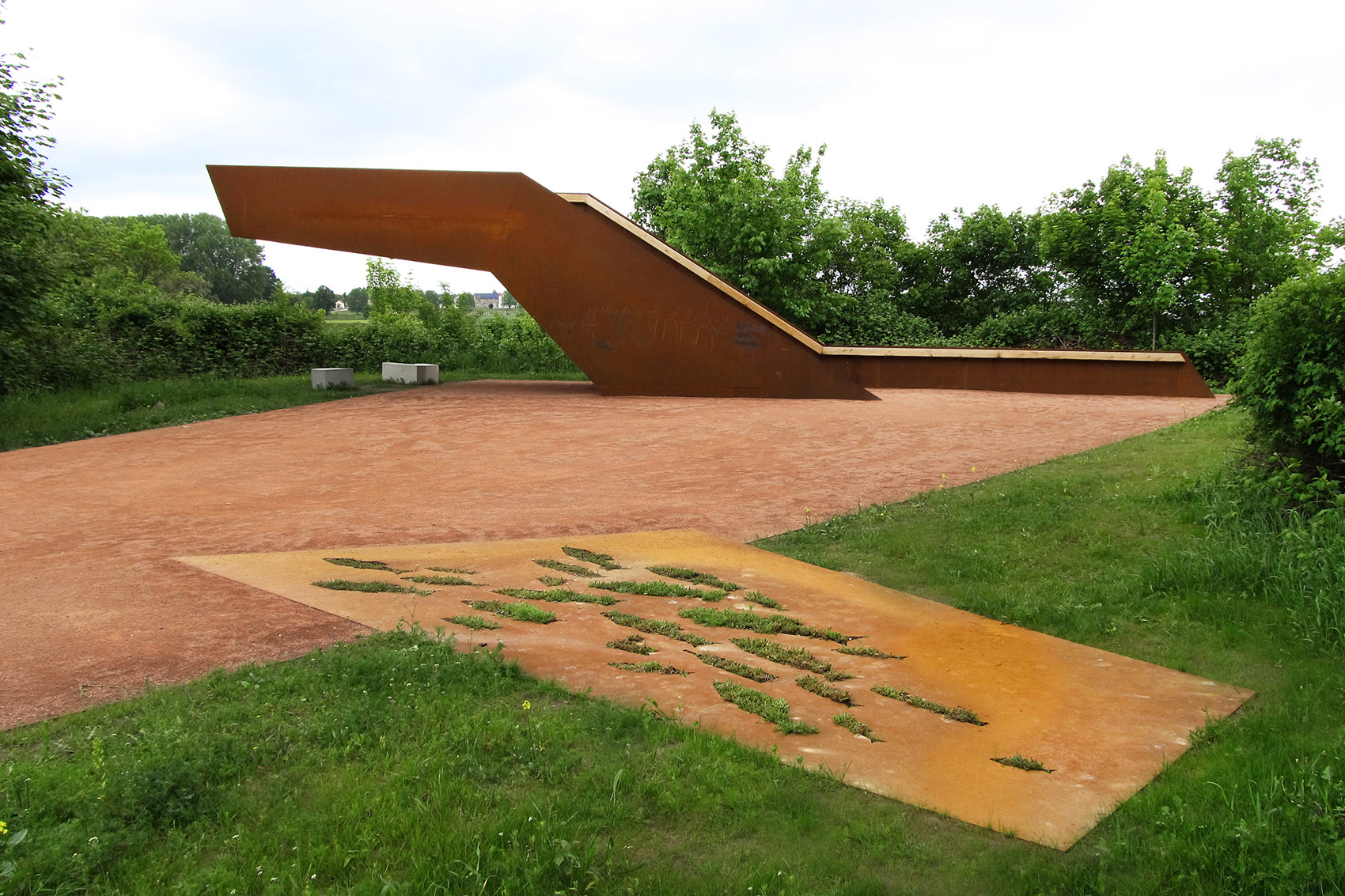
▲鏤空耐候案板指引游客通往瞭望臺(tái)���,hollow weatherproof board guides visitors to the observation deck ? REHWALDT LANDSCAPE ARCHITECTS

▲被小型綠植填充的游魚圖案���,swimming fish pattern filled with small green plants ? REHWALDT LANDSCAPE ARCHITECTS
聳立于港口入口處高地的瞭望臺(tái),以其簡(jiǎn)潔明朗的工業(yè)造型���,成為了城市的新地標(biāo)之一���。瞭望臺(tái)給游客們提供了眺望易北河開闊景觀的新視角。高聳眺望臺(tái)既引人注目��,又與河岸景觀融為一體���,成為易北河畔上一道新的風(fēng)景線����。明快硬朗的造型為易北河增添了新的活力�����。
The observation deck on the high ground at the entrance of the port has become one of the new landmarks of the city with its simple and clear industrial shape. The observation deck provides visitors with a new perspective on the open landscape of the Elbe River. The towering observation deck is both eye-catching and integrated with the riverbank landscape, and has become a new scenic line on the river Elbe. The crisp and tough shape adds new vitality to the Elbe.
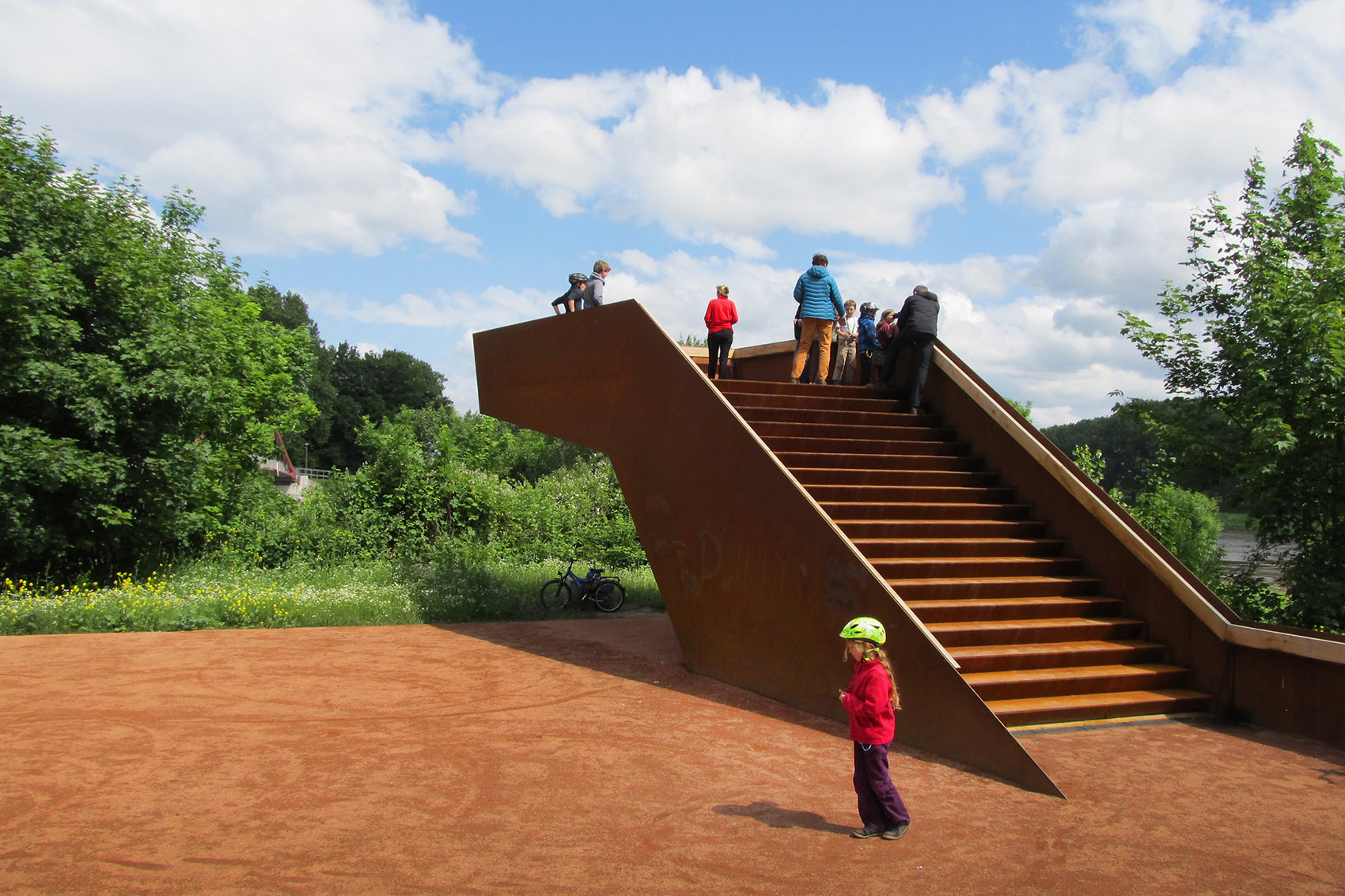 ▲瞭望臺(tái)與透水地面的色彩呼應(yīng),自然的材質(zhì)與周邊環(huán)境和諧相融����,The observatory echoes the color of the permeable sandy ground, so that the landscape facilities are naturally integrated with the surrounding environment ? REHWALDT LANDSCAPE ARCHITECTS
▲瞭望臺(tái)與透水地面的色彩呼應(yīng),自然的材質(zhì)與周邊環(huán)境和諧相融����,The observatory echoes the color of the permeable sandy ground, so that the landscape facilities are naturally integrated with the surrounding environment ? REHWALDT LANDSCAPE ARCHITECTS

▲木質(zhì)扶手讓憑欄更舒適,wooden handrails make leaning more comfortable ? REHWALDT LANDSCAPE ARCHITECTS
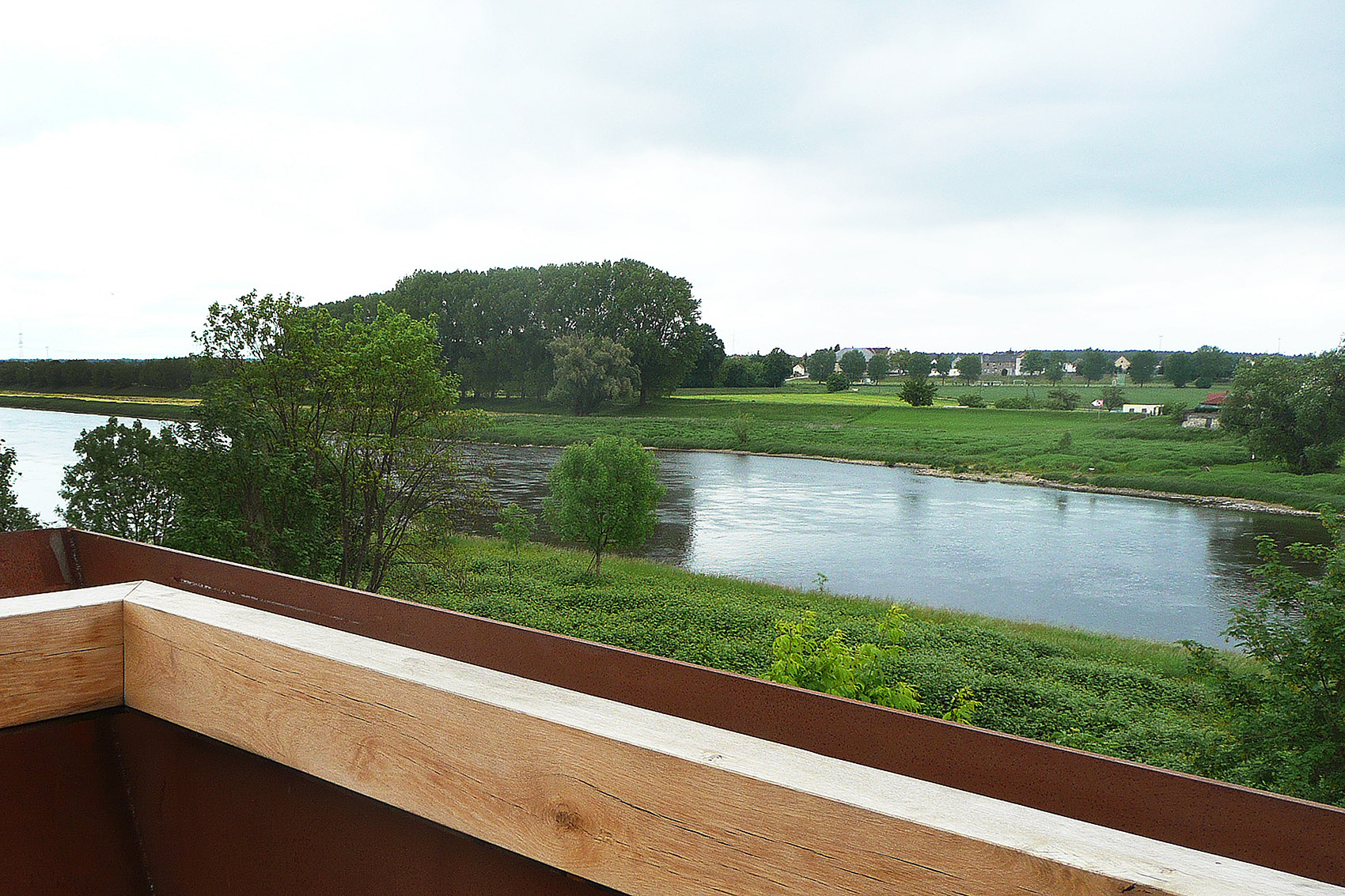
▲面向易北河的開闊視野�,open view towards the Elbe ? REHWALDT LANDSCAPE ARCHITECTS
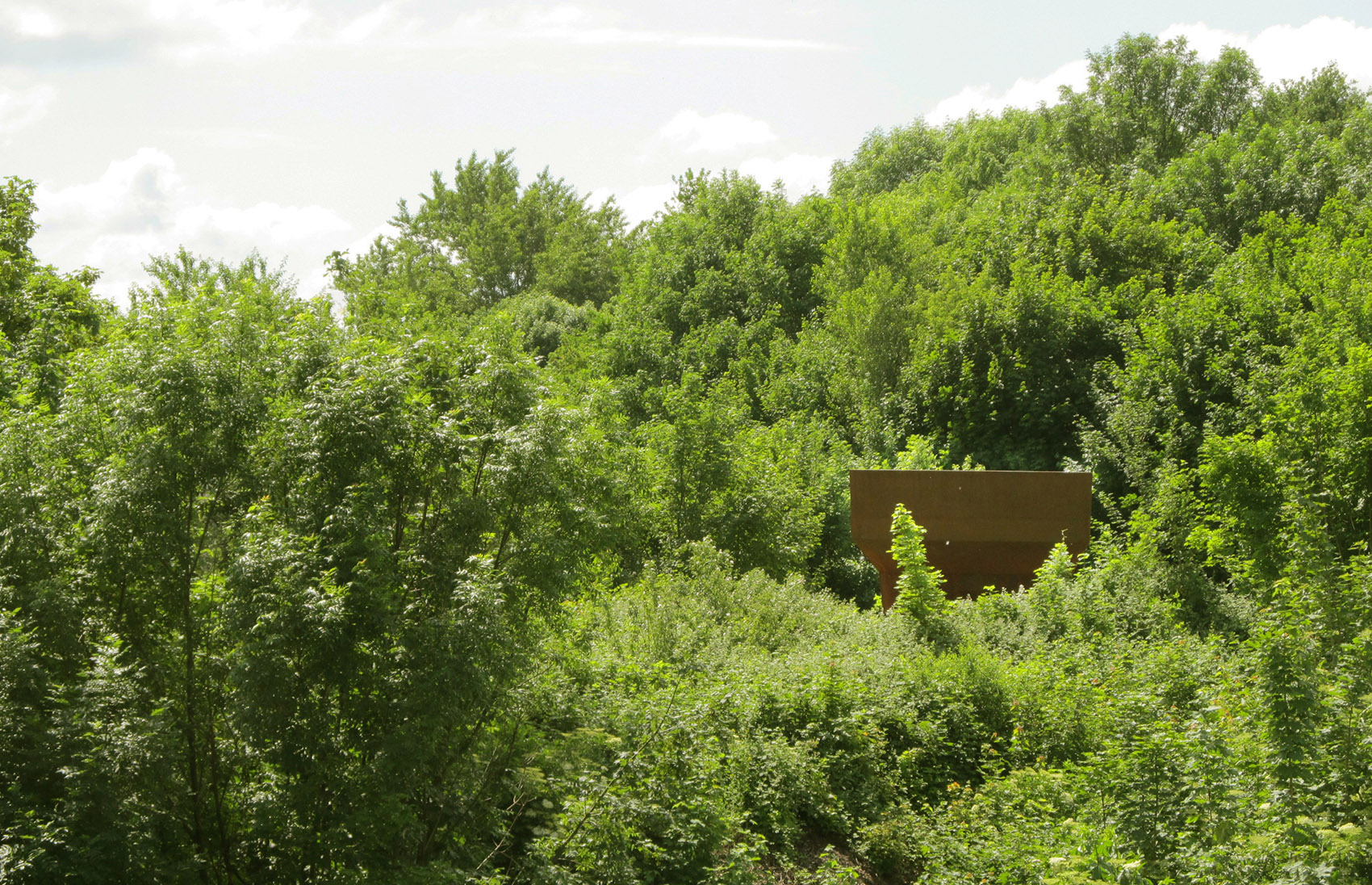
▲顯眼的色彩和幾何的造型,使人們一眼就能在蔥郁中發(fā)現(xiàn)瞭望臺(tái)��,The conspicuous color and geometric shapes make people discover the observation deck in the lush greenery at a glance ? REHWALDT LANDSCAPE ARCHITECTS
帶狀公園
Strip Park
帶狀公園緊鄰薩克森州立研究所��。公園設(shè)置了大量長(zhǎng)椅方便工作人員午間休憩�。據(jù)研究,散步可以提高腦力勞動(dòng)的效率����,由此我們特意設(shè)置了長(zhǎng)長(zhǎng)的沿河步道。
The Strip Park is next to the Saxon State Institute. A large number of benches are set up in the park for the staff to take a break at lunchtime. According to research, walking can improve the efficiency of mental work, so we have specially set up a long walk along the river.
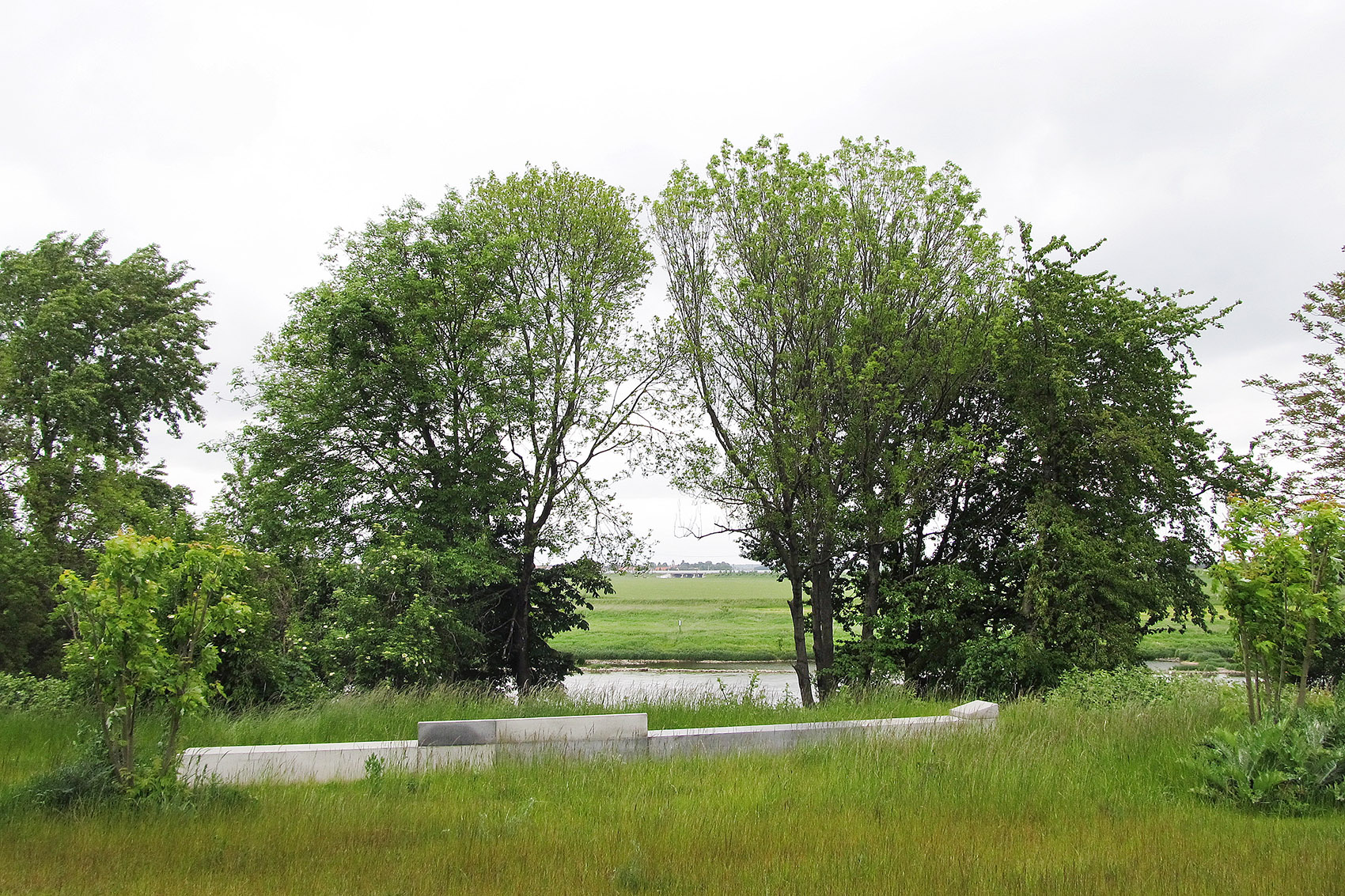
▲休閑座椅沿河布置�����,benches laid out along the river ? REHWALDT LANDSCAPE ARCHITECTS
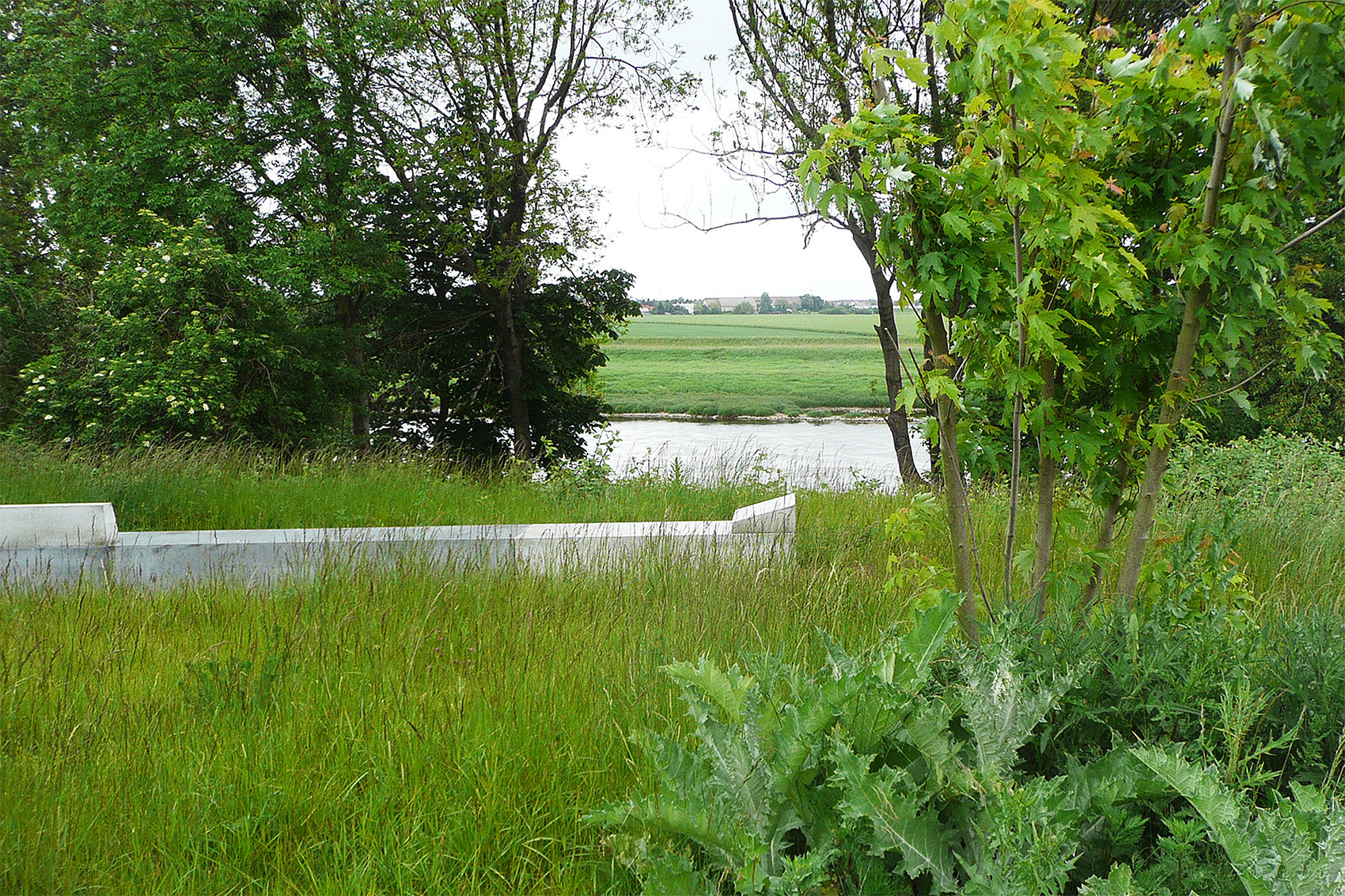
▲座椅落點(diǎn)將游客引向最佳觀景角度�,the seating point will guide visitors to the best viewing angle ? REHWALDT LANDSCAPE ARCHITECTS
人們可以在舒適的座椅上安靜閱讀�����,或欣賞河岸景色,享受寧?kù)o與自然�����。由木材�、鋼材等材料構(gòu)成小品不僅連通了場(chǎng)地內(nèi)的設(shè)施,還能夠傳遞信息與知識(shí)�����。
People can read on the benches, enjoy the riverbank views, and enjoy the tranquility and nature. Outdoor furniture made of materials such as wood and steel not only connects the facilities in the site, but also conveys information and knowledge.
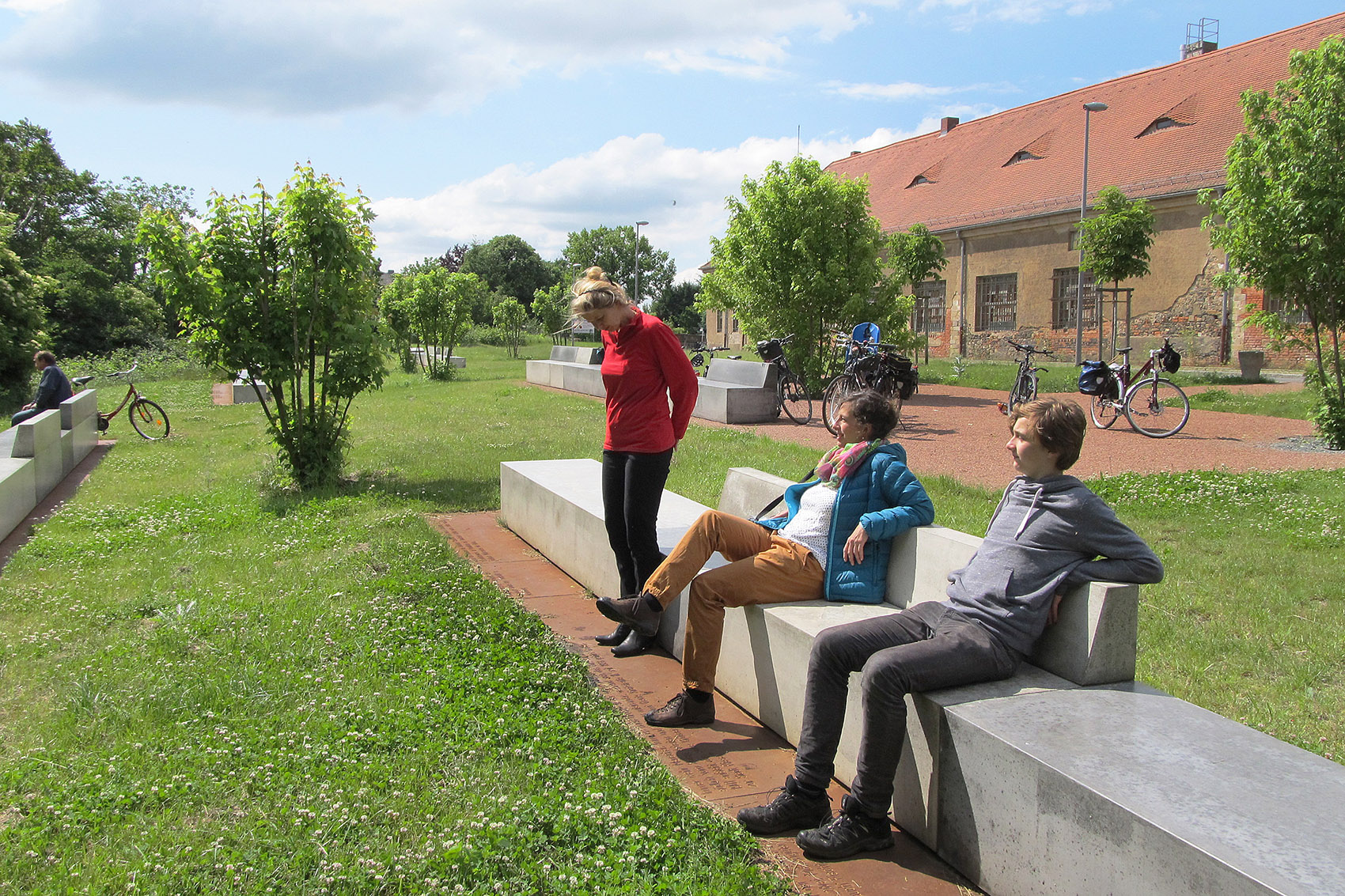
▲座椅邊的鋼板免于草坪被踩踏���,the steel plate is protected the lawn from being stepped on ? REHWALDT LANDSCAPE ARCHITECTS
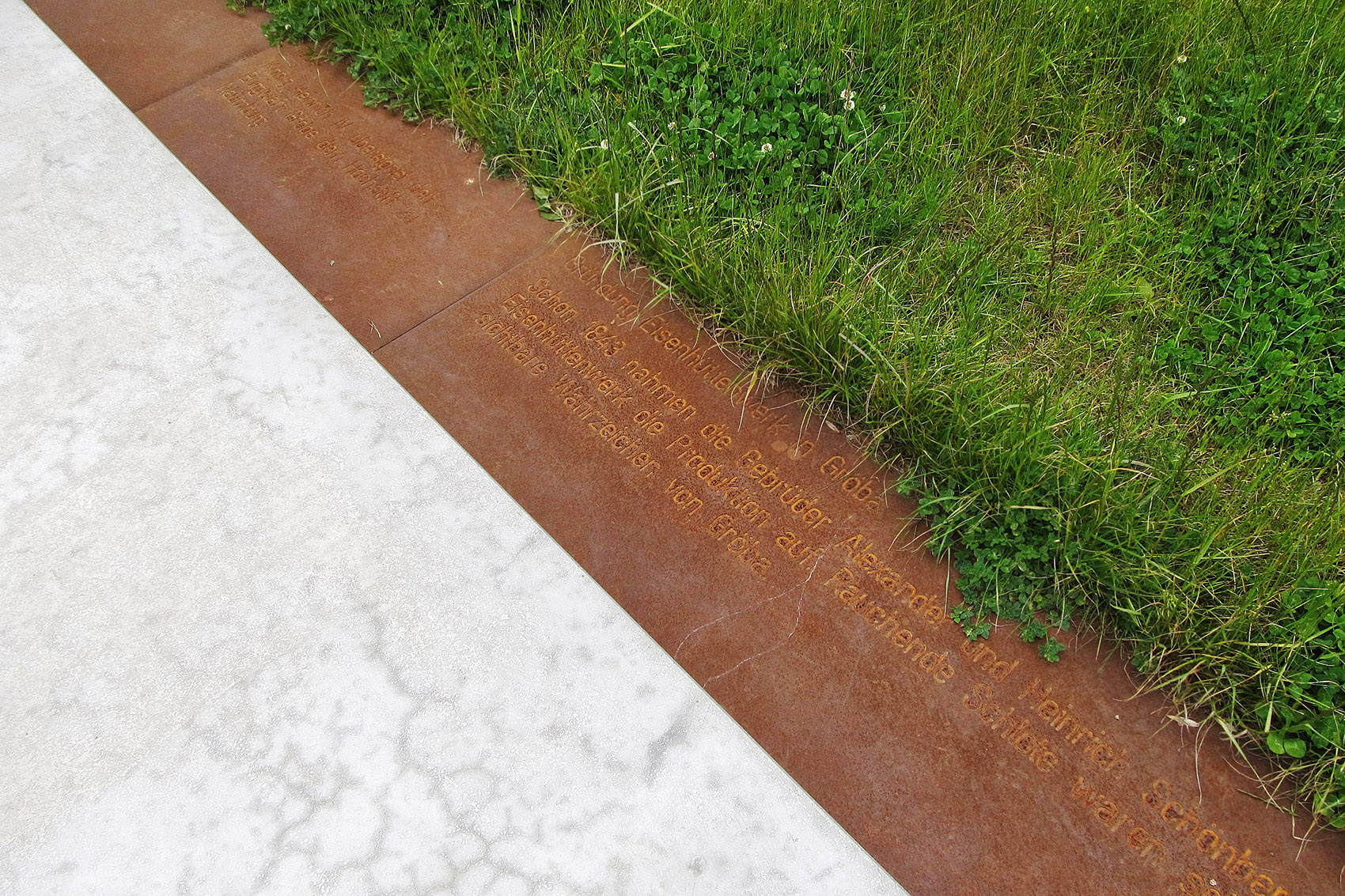
▲鋼板上可以閱讀場(chǎng)地的信息���,site information can be read on the steel plate ? REHWALDT LANDSCAPE ARCHITECTS
聲音迷宮
Labyrinth of Sound
過去航運(yùn)時(shí),人們會(huì)使用傳聲喇叭在港口與海岸間的進(jìn)行交流����。它和管道研究中心共同為我們的“聲音迷宮”提供了設(shè)計(jì)靈感。金屬喇叭中的一部分用于收集聲音��,另一部分則把聲音釋放出來(lái)��。至于哪些喇叭互相連通�����,則要人們親身探索。
In the past, when shipping, people used sound horns to communicate between the port and the coast. It and the Pipeline Research Center provided design inspiration for our “Labyrinth of Sound”. One part of the metal horn is used to collect sound, and the other part is to release the sound. As for which speakers are connected to each other, people need to explore for themselves.
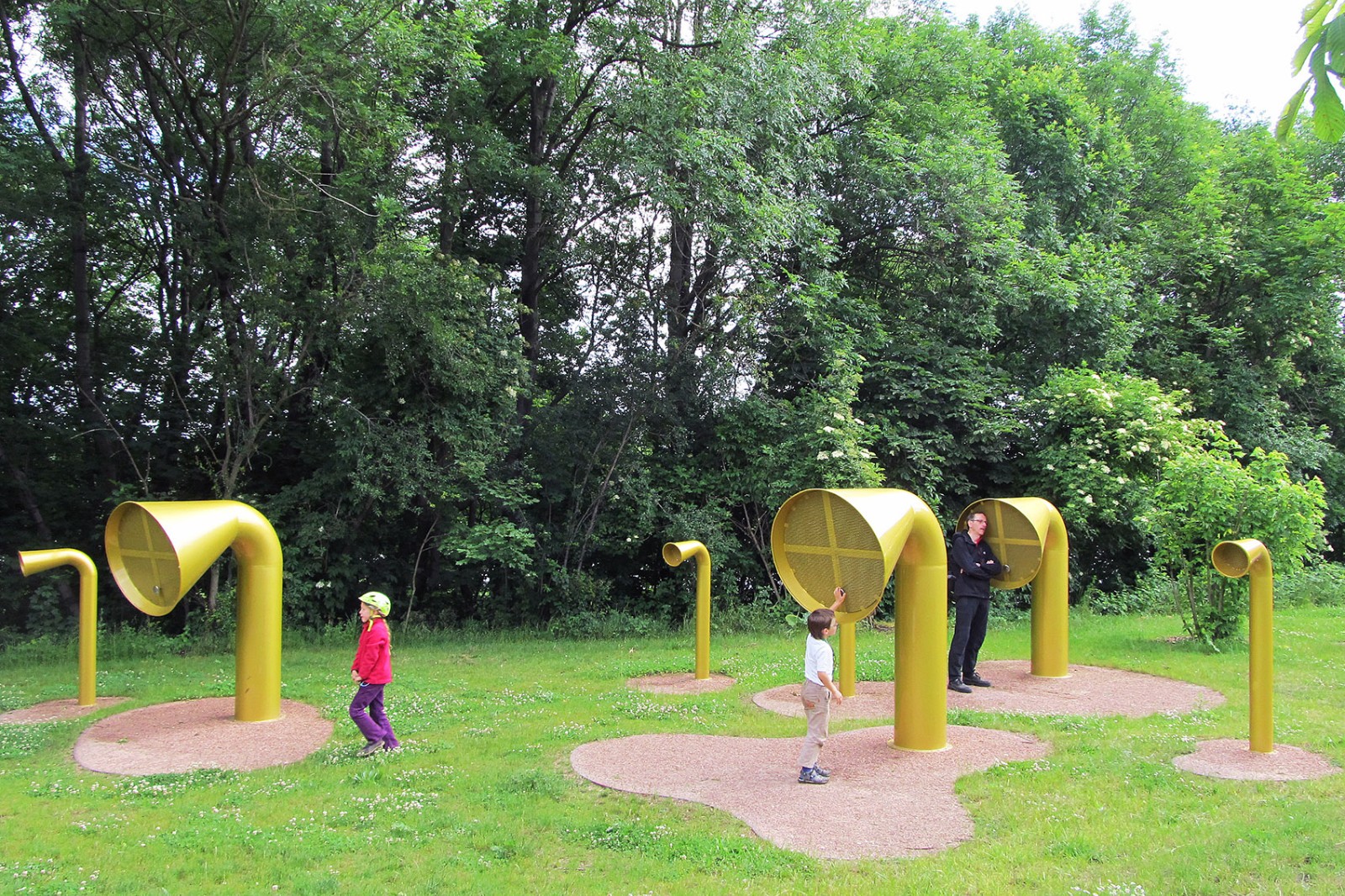
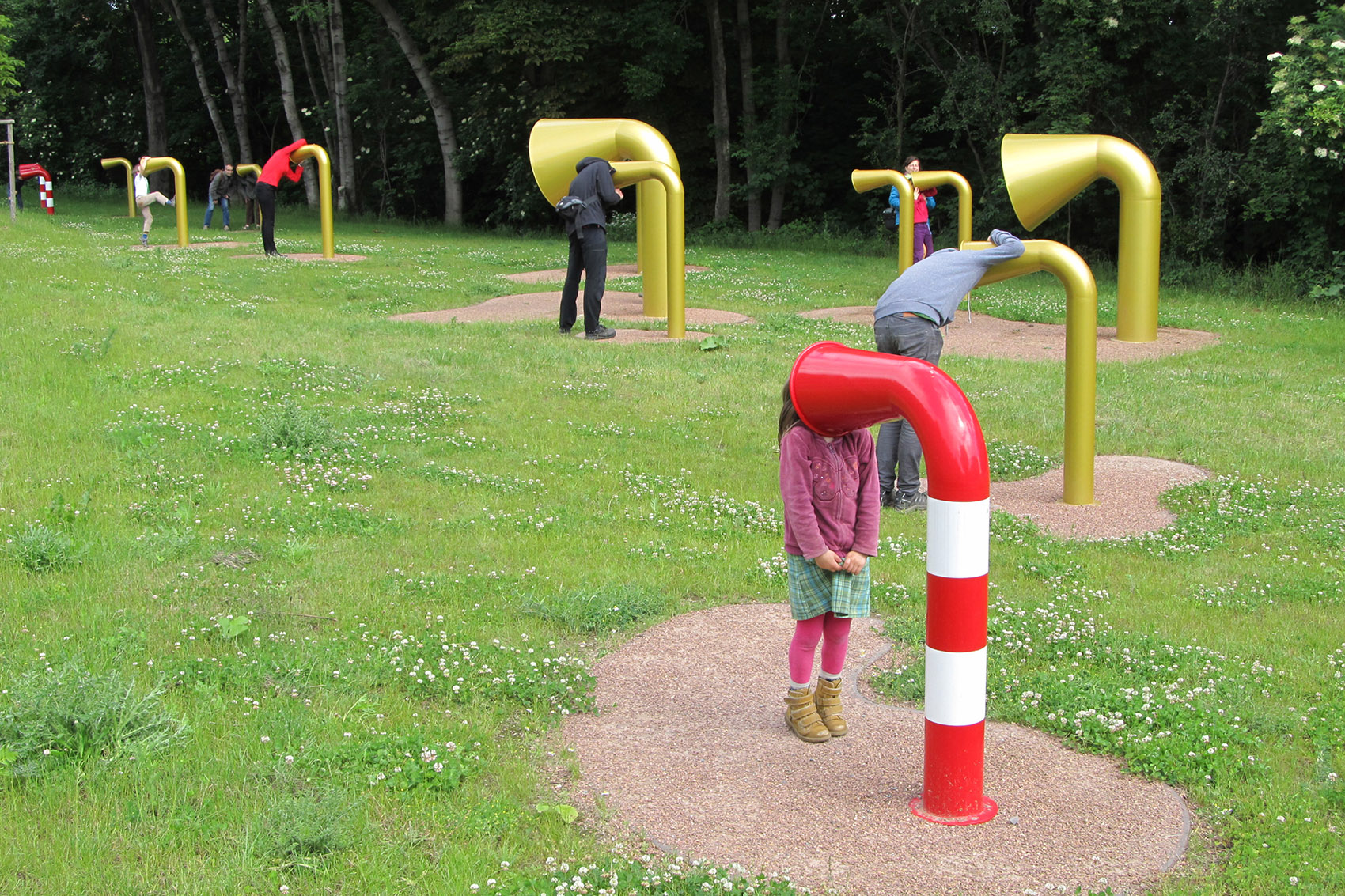
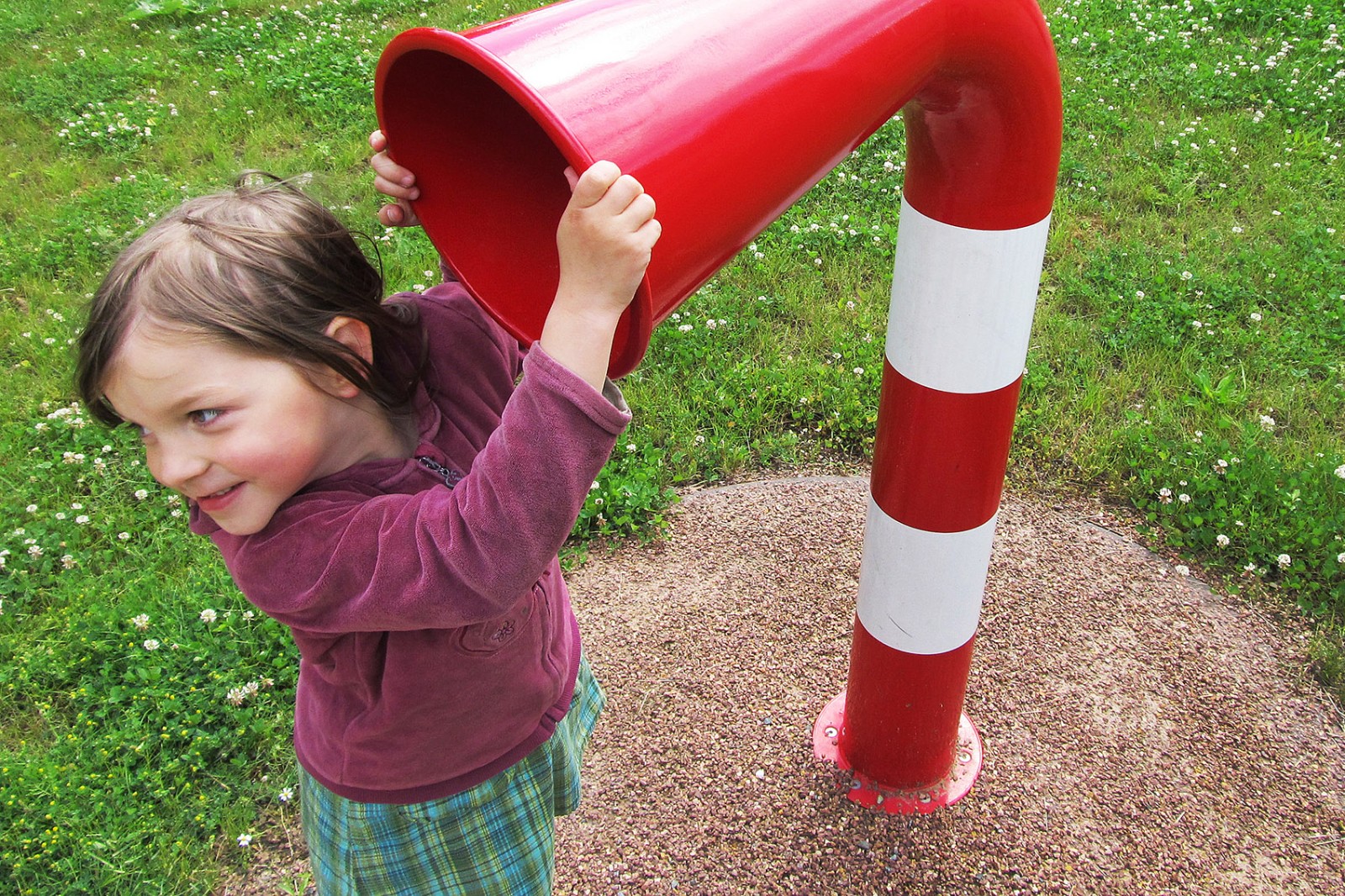
▲喇叭通過蜿蜒的管道相連�,形成聲音的迷宮, the horns are connected by winding pipes, forming a maze of sound ? REHWALDT LANDSCAPE ARCHITECTS
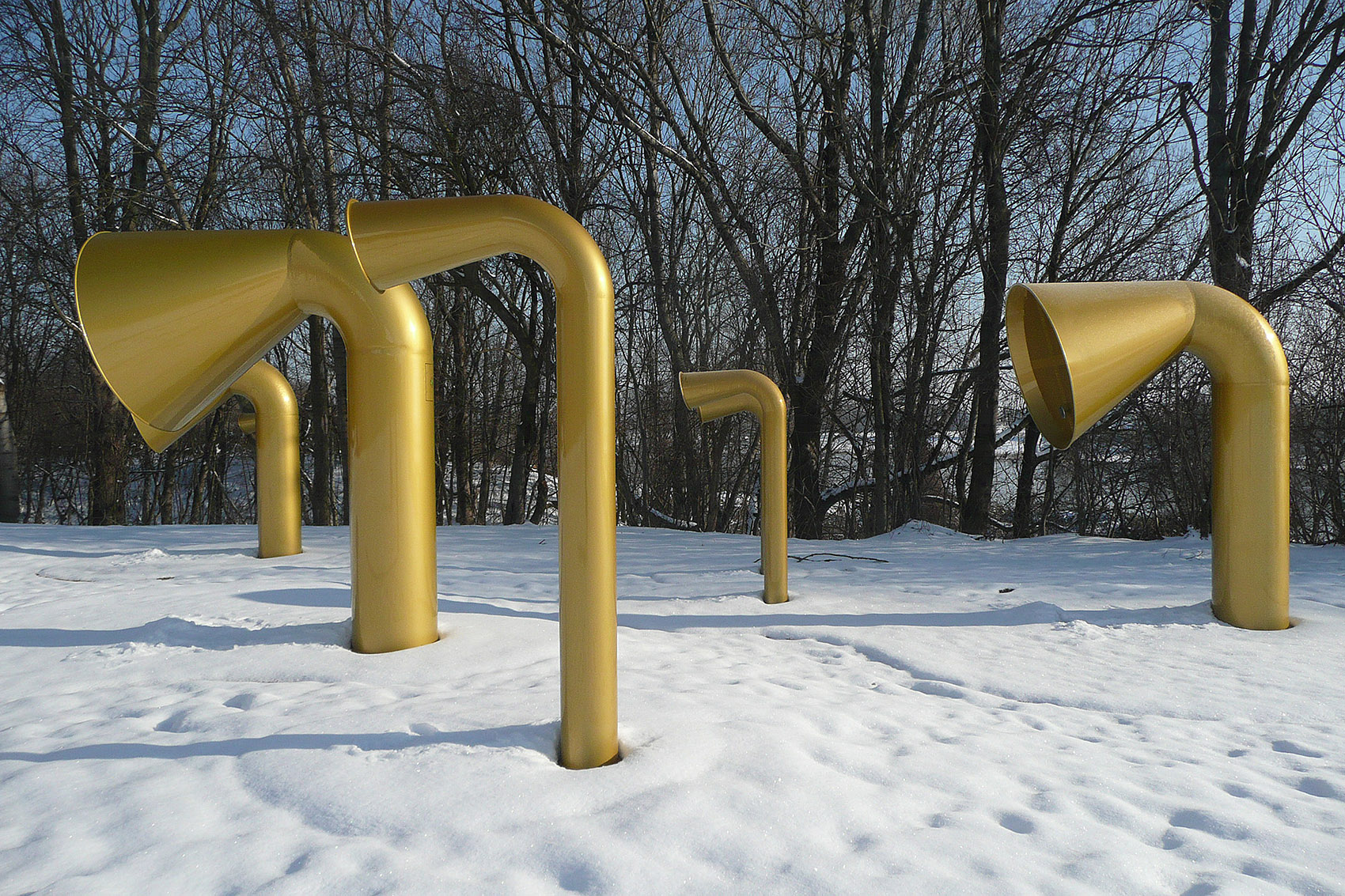

▲光滑金屬與皚皚白雪的質(zhì)感對(duì)比���,the texture contrast of smooth metal ? REHWALDT LANDSCAPE ARCHITECTS

▲總平面圖�,河畔公園連接綠帶��,General Layout, River Park connects the green belt ? REHWALDT LANDSCAPE ARCHITECTS
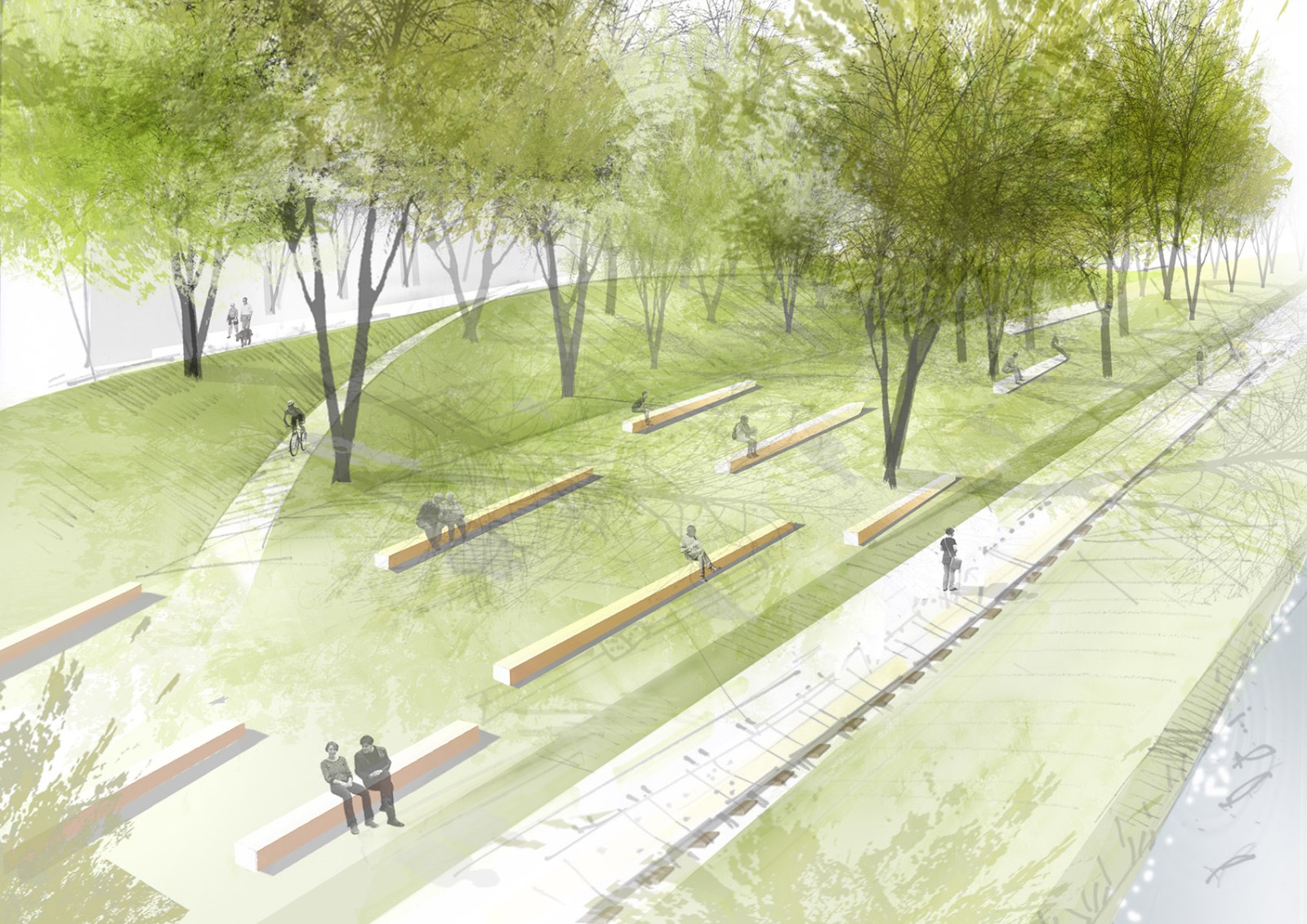
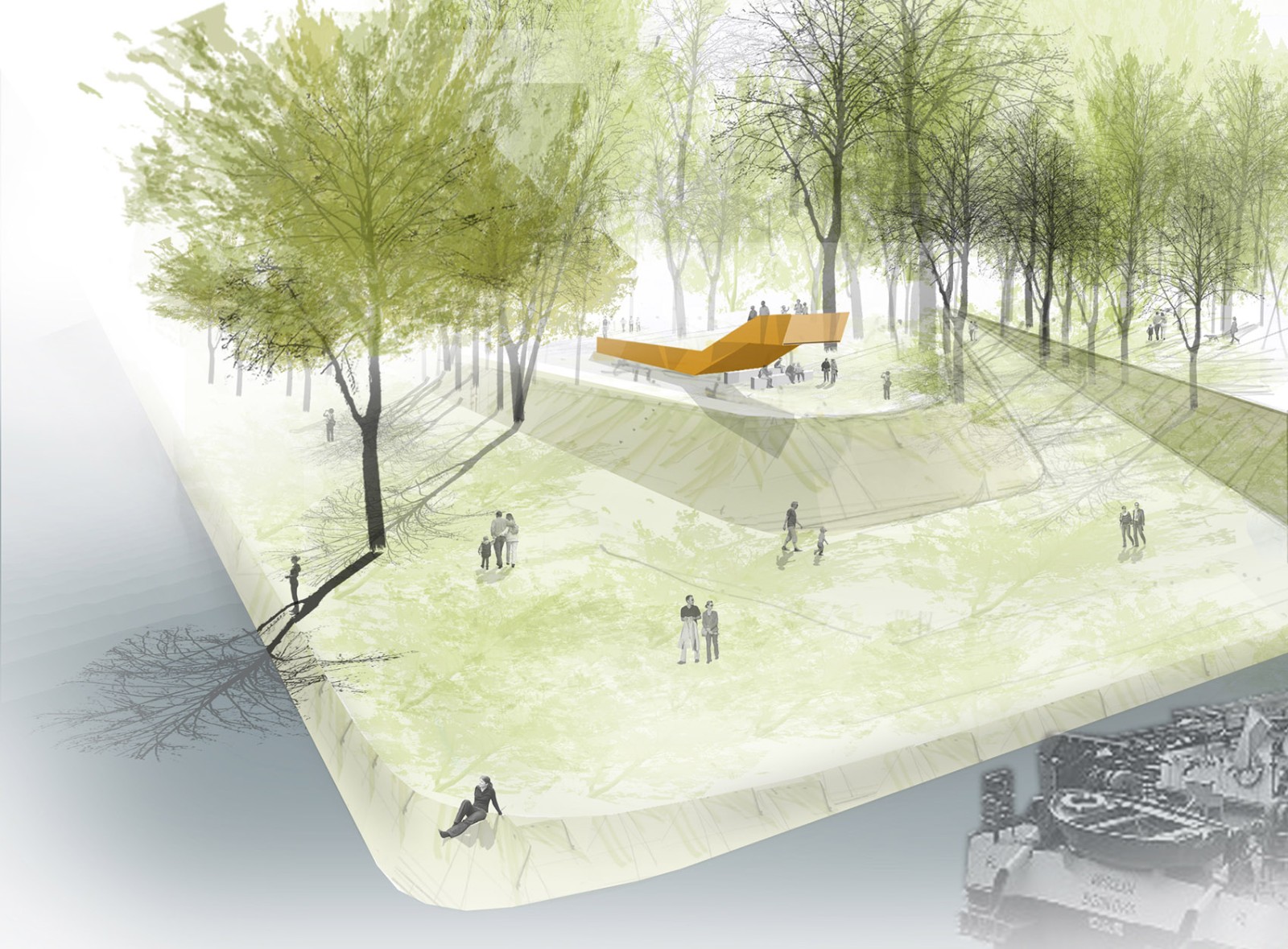
▲效果圖 ? REHWALDT LANDSCAPE ARCHITECTS
項(xiàng)目名稱:里薩易北河畔公園
設(shè)計(jì)方:德國(guó)雷瓦德景觀建筑事務(wù)所
公司網(wǎng)站:https://rehwaldt.de/
聯(lián)系郵箱:beijing@rehwaldt.net
項(xiàng)目設(shè)計(jì) & 完成年份:2009���,2013
主創(chuàng)及設(shè)計(jì)團(tuán)隊(duì):
Projektleiter: S. Fauck; Mitarbeiter: S. Hübner, T. Gebhardt, F. Bergander, M. Hoffmann
項(xiàng)目地址:里薩(德國(guó))
建筑面積:5.6 公頃
攝影版權(quán):REHWALDT LANDSCAPE ARCHITECTS
客戶:里薩市政府
Project name: Riesa Elbe Riverfront Park
Design: Rehwaldt Landscape Architects
Website: https://rehwaldt.de/
Contact E-mail: beijing@rehwaldt.net
Design year & Completion Year: 2009 & 2013
Leader designer & Team:
Projektleiter: S. Fauck; Mitarbeiter: S. Hübner, T. Gebhardt, F. Bergander, M. Hoffmann
Project location: Riesa, Germany
Gross Built Area (square meters): 5.6 ha
Photo credits: REHWALDT LANDSCAPE ARCHITECT
Clients: City of Riesa
版權(quán)聲明:本文由作者于景觀中國(guó)網(wǎng)發(fā)布�����,僅代表作者觀點(diǎn)���,不代表景觀中國(guó)網(wǎng)立場(chǎng)。如轉(zhuǎn)載���、鏈接、轉(zhuǎn)貼或以其它方式使用本稿���,需注明“文章來(lái)源:景觀中國(guó)網(wǎng)”�����。如有侵權(quán)�����,請(qǐng)與發(fā)布者或我們聯(lián)系�。
投稿郵箱:info@landscape.cn
項(xiàng)目咨詢:18510568018(微信同號(hào))
 京公海網(wǎng)安備 110108000058號(hào)
京公海網(wǎng)安備 110108000058號(hào)





















